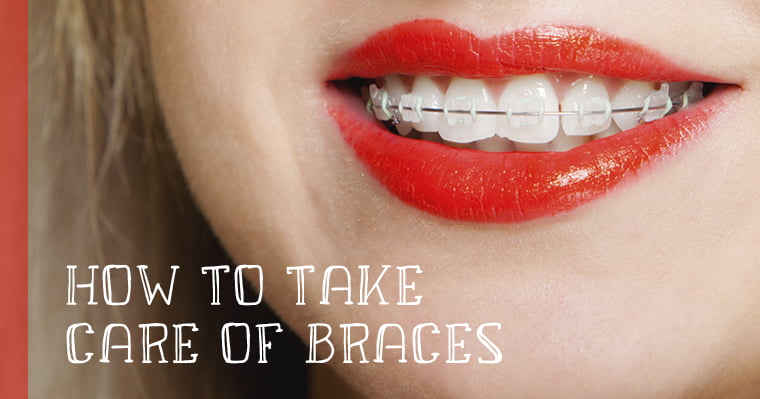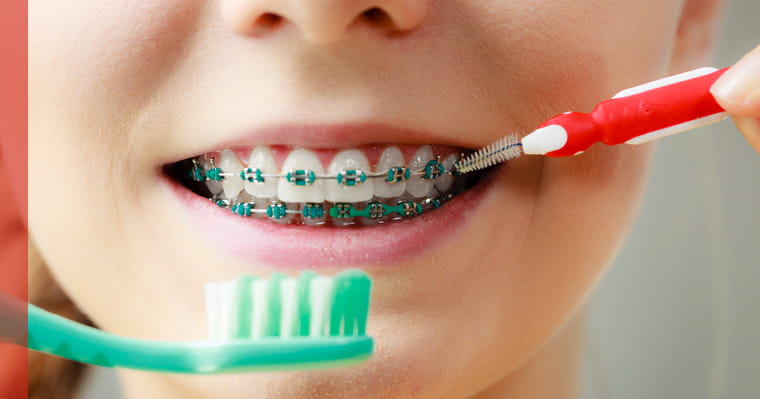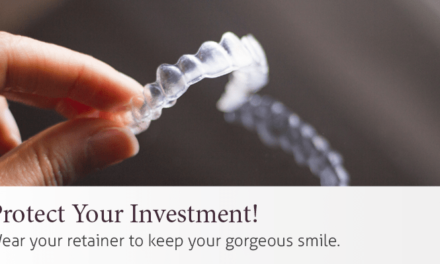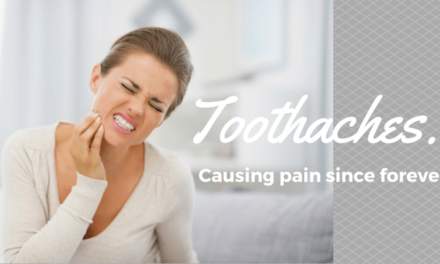
Finally, after months (maybe even years) of anticipation, you get your braces off…only to have your straight smile overshadowed by the unhealthy state of your teeth.
You ask, how are my teeth worse than before orthodontic treatment?
Your dentist or orthodontist reminds you, yet again, you didn’t take proper care of your teeth with braces, just like this blog advised…
Don’t let this tale become yours. Read our blog to learn everything new braces wearers need to know about caring for braces.
A new hygiene routine with braces
Now more than ever, is it essential that you take excellent care of your teeth with braces. Braces have many areas for food to get trapped, and these food particles encourage the buildup of plaque, which can cause dental problems, such as:
- Stained teeth
- Gum disease
- Cavities
To keep your teeth healthy and clean with braces, follow our recommended hygiene routine:
How to floss with braces
If you weren’t flossing your teeth at least once a day before braces, you must start now. Carefully thread your floss between your teeth and the wire, and slowly move it back and forth between your teeth. It’s important that you are gentle with the floss or it can damage your braces.
While it may seem challenging to floss your teeth with braces, there are tools to help you or your child. Use a floss threader or orthodontic flosser to quickly and easily thread floss under your wires. You can find these flossing tools at most drug stores or online at Amazon.
Helpful tip: Waxed floss is less likely to snag on your braces and it is easier to slide between your teeth than unwaxed floss.
Brushing your teeth with braces
Forget brushing your teeth twice a day. With braces, you need to brush your teeth after every meal – midday snacks and late night munchies count too.
First, remove any removable orthodontic parts, like elastics. Hold your toothbrush at a 45-degree angle and begin by brushing each bracket, using a downward angle to get the tops and an upward angle to get the bottoms. Next, starting at each tooth’s gum line, brush each tooth, both front and back, in a circular motion. Once complete, look in a mirror to check for any leftover food particles.
Helpful tip: Use an electric toothbrush with a small head and soft bristles. From the settings, like timers and brush intensity, to the ease of use, electric toothbrushes provide excellent cleaning results for braces wearers.
Rinse with mouthwash
Lastly, rinse with mouthwash to ensure that any harmful bacteria left behind are killed. Many dentists recommend fluoride toothpaste and mouthwash for adults, but those may not be suitable for children. Ask your dentist or orthodontist for their recommendation on dental products with braces.
Helpful tip: Since you can’t chew gum with braces, keep a small bottle of mouthwash at your desk or in your purse to freshen your breath and kill harmful bacteria.
Visit your orthodontist and dentist regularly
With braces, you will need to frequently visit your orthodontist. At these appointments, your orthodontist will adjust your braces and keep your smile moving along. Avoiding or delaying these appointments will only leave you in braces longer.
It’s also important that you see your dentist for regular check-ups and cleanings. Your dentist will be able to spot any signs of danger, like cavities or gum disease, and adjust your hygiene routine as needed.
Helpful tip: Some dentists request their patients with braces to have their wire removed by their orthodontist before their cleaning. If your dentist requests this, plan ahead and have your orthodontic and dental appointments on the same day to minimize your time without a wire.

Foods to avoid with braces
There are certain foods you should avoid with braces, and for good reason. As a rule of thumb, avoid foods that are sticky, chewy, hard, or sugary and starchy. These foods are known to build up plaque, get stuck between your teeth, damage your brackets or wires, or stain your teeth.
Here is a quick list of foods to avoid with braces:
- Sticky and chewy food: gum, caramels, corn on the cob, gummy candy, dried fruit
- Crunchy and hard food: popcorn, apples, carrots, ice cubes, nuts, hard candy
- Sugary and starchy food: soda pop, fruit juice, white rice or bread, desserts
Thankfully though, braces aren’t forever. Just imagine how good these foods will taste once you have your braces off.
Protect your smile with braces
If you or your child plays a sport, you should wear a mouth guard. A mouth guard will not only protect your braces from getting damaged, but it will also protect your gums and lips from your braces. Typically, mouth guards cover your upper teeth, but if you have lower braces, you may want to get full mouth protection. Talk to your dentist or orthodontists about your mouth guard options.
As your teeth move, you may experience some chaffing on the inside of your lips or cheeks. To prevent this from happening or getting worse, place a special wax on the nearest bracket. You can buy this wax at drug stores, or it may be complimentary with your treatment.
Accidents happen, like a broken-off bracket or snapped wire. If you experience something similar, contact your dentist or orthodontist right away. Depending on the severity of the situation, they will likely schedule you an appointment and have your braces fixed in no time.
Remember, it’s an investment
Caring for braces is a lot different than before. It’s no secret that these extra steps will take additional time, but remember, braces are an investment that will benefit you for the rest of your life.
If you want your tale to end with a straight AND healthy smile, you must take special care of your teeth with braces. If you have questions about caring for braces, contact your orthodontic provider today!
The content on this blog is not intended to be a substitute for professional medical advice, diagnosis, or treatment. Always seek the advice of qualified health providers with questions you may have regarding medical conditions.



